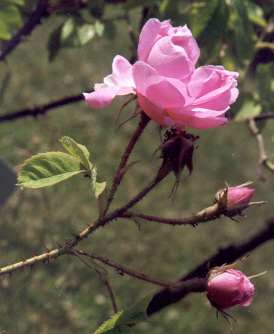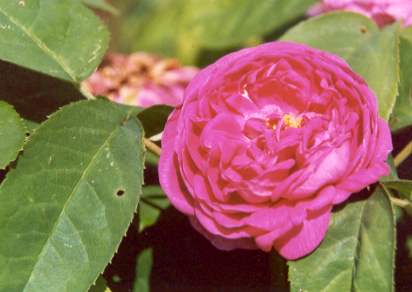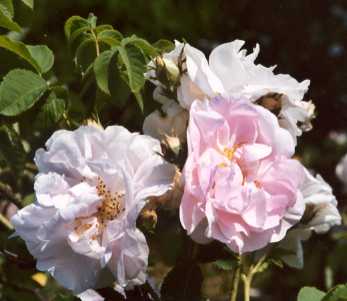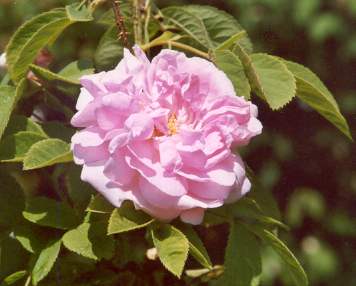The content of essential oil in the petals is poor and far below 1%. Because of
the volatility of rose oil, the content is highest on the first morning when
the flower opens; therefore, rose flowers used for distillation are picked
manually, day by day, before or at sunrise.
Characteristic components of rose oil are acyclic monoterpene alcohols,
geraniol (up to 75%), citronellol (20%) and nerol (20%), and long-chain
hydrocarbons like nonadecane or heneicosane (up to 10%).
An important trace
component of rose oil is β-damascenone: Despite its low
concentration (0.01%), that C13-norisoprenoid has notable
influence on the quality of the oil; together with the structurally related
compounds β-damascone and β-ionone, it is enzymatically generated from
carotenoids. Similarly, in both saffron and
pandanus leaves, the dominant aroma molecules
derive from enzymatic degradation of carotenoids.
Characteristic of the fresh flower’s odour is 2-phenyl ethanol, which is,
though, lost during steam distillation and accumulates in the rose water.
Thus, rose oil and rose water do not equal each other exactly.
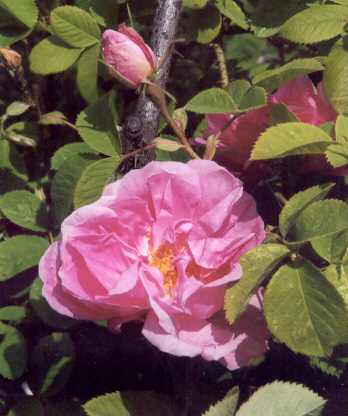
|
|
Damask Rose Quatre Saisons Continue
|
Even in the best case, only 10 g of the essential oil are
distilled from as much as 100 kg fresh rose flowers (0.01%).
Redistillation of the by-product rose water triples the yield, so that
approximately 3000 to 5000 kg fresh rose flowers are needed for
1 kg rose oil.
Alternatively, extraction by solvents, typically hexane, can be used
to obtain a semisolid, greenish mass (concrete). The yield is about
ten times as high as with distillation, and moreover, the natural
content of 2-phenyl ethanol is preserved (ca. 60% of total volatiles).
Origin
Several plants of genus Rosa grow wild in from Western
Europe to East Asia, with a center of diversity in Central Asia. Due to
centuries of breeding, the original botanical relations between wild rose
species are far from clear.
Most European rose varieties stem at least in part from
Rosa gallica, which grows wild in the Caucasus Mountains.
It appears that almost all roses grown in Europe, Western or Central Asia and
North Africa, from antiquity to the 18.th century, either belong to
Rosa gallica or are gallica-derived varieties.
Possible exceptions to that rule are the musk rose
(Rosa
moschata, India) or the Holy rose of Abessinia
(Rosa
richardii).
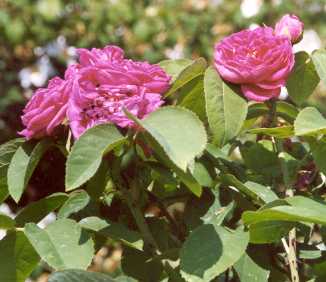
|
|
Damask rose Rose de Resht
|
Damask rose is a fertile hybrid of Rosa gallica with either
Rosa phoenicia or Rosa moschata, and it
is known since antiquity (see also Silphion); it
is suspected that the hybrid first arose in Anatolia several millennia ago.
Damask rose (or, in any case, roses very similar to today’s Damask rose) were
known in Western Asia since the Bronze Age, and its cultivation later spread to
Greece and Rome.
Damask rose is the dominant source of rose oil (also known as rose
otto), although in the European middle ages, rose oil was obtained
from R. gallica flowers. In France and North Africa,
rose oil is still obtained from R. centifolia and
centifolia–gallica hybrids. The rose mentioned in
the Capitulare de villis of Charlemagne is probably dog’s
rose, R. canina (see lovage).
In China, native rose species (e. g., R. rugosa) have of old
been used as source for floral scents in perfumery and for producing
rose-flavoured black tea.
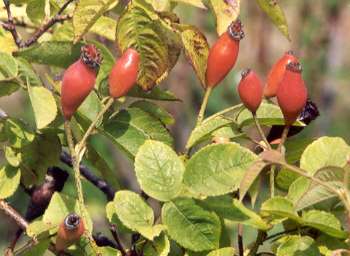
|
|
Fruits of Damask Rose
|
For the essential oil business, highly scented rose varieties (oil roses
)
are grown in large scale. Main production countries are France and Bulgaria in
Europe, but far more oil is produced in Turkey and Iran, where rose oil and rose water
are called for in religious ceremonies. Famous production sites are Shiraz and
Meshed (Iran), Isparta (Turkey) and the Kazanluk valley (also spelt
Kazanlik [Казанлък])
in Bulgaria.
Many more rose varieties are known, e. g., alba roses, which are probably
hybrids of Rosa damascena with the central European wild
species Rosa canina. Furthermore, there are
hundred-leaved
roses (Rosa centifolia), most popular in
Provence, which derived from Rosa gallica by
hybridization with another type, probably alba. They are named for the
large number of petals in their densely stuffed flowers.

|
|
Damask rose Gloire de Guilan
|
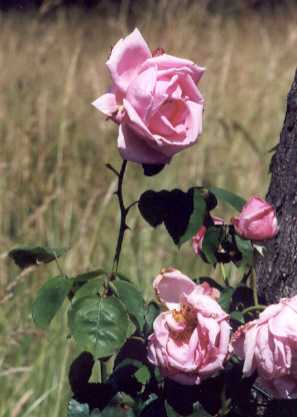
|
|
Tea hybrid Climbing Mme Caroline Testout
|
All these roses flower only on one-year old branches, which is why they have
only a short flowering period followed by development of new branches for
next year’s flowers (some Damask roses, though, show a second short bloom in
fall). The China rose Rosa chinensis is
different in bearing flowers of fresh branches, and can therefore flower and
grow all year round. With the genes of Chinese rose available, European
breeders created an amazing variety of new roses in the 18.th century.
Examples include Bourbon roses
, Portland roses
, Noisette roses
and
later
developments like Remontant roses
and Tea roses
with large, solitary
flowers. Inclusion of Rosa multiflora into the genetic pool
produces many-flowered roses, often referred to as polyantha and floribunda
types.
Old garden roses
is a term used for all roses bred before the introduction
of the first tea rose hybrid (La France) in 1867, and is
usually meant to include all varieties bread after 1867 that belong to types
known before 1867. All Damask roses are old
.
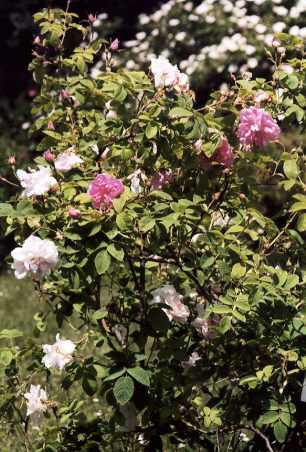
|
|
Damask Rose York and Lancaster with pink and white flowers
|
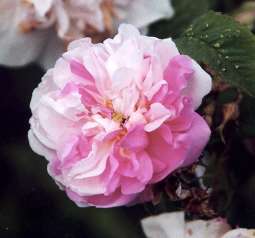
|
|
Damask Rose York and Lancaster with two-coloured flower
|
There is a number of different Damask rose cultivars, which now become more
and more available as interest in old roses
increases in Western countries.
Some of these, mainly from the East, are chiefly valued as sources of essential
oil, like the Ispahan rose (named after the Central Iranian city Isfahan [اصفهان])
or the Bulgarian rose (Bulgarska roza [Българска роза]),
which is also known as trigintipetala thirty-petaled
for its semi-filled flowers.
Others, however, serve mainly ornamental purpose; most of these were developed
during the 17.th and 18.th centuries by European breeders. Examples include
Celsiana,
Léda, Duc de Cambridge,
Quatre Saisons, Ville de Bruxelles and
Gloire de Guilan. A somewhat problematic case is
the Rose de Resht, an unusually hardy variety, which is
sometimes thought to be a gallica, although it was apparently
imported from Iran.
The Damask rose cultivar York and Lancaster is named in reference of
the so-called rose war
between the House of York and the House of Lancaster
(1455–1485). The two houses were represented by
emblems showing the White Rose of York
(Rosa alba
Maxima
) and the Red Rose of Lancaster
(Rosa
gallica Officinalis
); as a sign of reconciliation,
the victorious House of Tudor chose a new rose with inner white and outer red
petals as its heraldic symbol. No breeder has ever succeeded to create a rose
of that two-coloured kind, but Rosa damascena versicolor
York and Lancaster
(a 16.th century achievement) comes close in having
reddish–pink and white flowers on the same plant; occasionally, one finds
even flowers combining both colours in one.
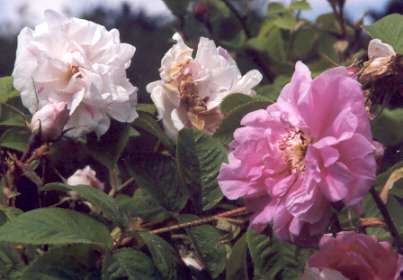
|
|
Damask Rose York and Lancaster with two flower colours
|
Etymology
The name rose can be traced back, via Latin rosa, only
to Greek rhodon [ῥόδον]
(cf. the name of the common ornamental rhododendron [ῥοδοδένδρον] rose tree
),
but not further; the plant must have been known in bronze-age Greece as it
appears in the Odysseia [Ὀδυσσεῖα]
(see poppy on the Homeric epics).
We do not know, however, which rose variety inspired the poet to his famous
comparison of the goddess of dawn and rose flowers:
rhododaktylos Eos [ῥοδοδάκτυλος Ἠῶς]
rosy-fingered Eos
.
The source of Greek rhodon is probably a tongue of Western
Asia now lost. There are, however, related words that are no Greek loans,
but derived from the unknown predecessor language by an independent route:
Armenian vart rose
[վարդ],
Georgian vardi [ვარდი],
Arabic al-ward [الورد],
Hebrew vered [ורד] and
Coptic urt [ⲟⲩⲣⲧ].
From Arabic, the word spread to a number of languages in Islâmic countries
of Africa and Asia. Compare also Slovenian vrtnica rose
(besides
rož) and the female name Warda popular in the
Eastern Mediterranean.
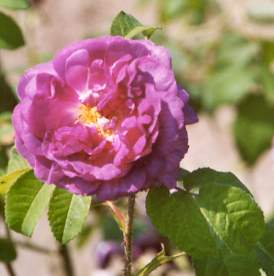
|
|
Gallica rose Président de Sèze
|
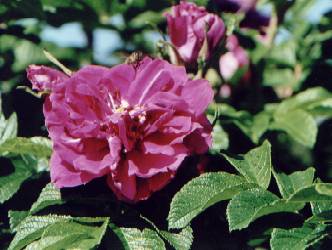
|
|
R. rugosa, originally from China and Japan
|
The Latin name rosa, itself derived from Greek, is essentially
the source of almost all names of rose in modern European tongues, mostly with
at most only slight variation: The name rose is not only valid in
English, but also in German, Danish and French; other Germanic names are
Icelandic rós, Swedish ros and Dutch
roos. The Romance languages Italian, Spanish and Portuguese
have another common name, rosa. In Baltic and Slavonic tongues,
the S sound got voiced throughout, and sometimes also palatalized:
Latvian rozes, Lithuanian rožės,
Czech růže, Polish róża
and Russian roza [роза].
Basque has an initial vowel, arrosa.
Examples of loans to non-European tongues are Kannada roja [ರೋಜಾ]
and Japanese rozu [ローズ].

|
|
R. rugosa, originally from China and Japan
|
Yet we find a paradoxical situation also encountered with
some other spice names (parsley,
ginger): Although the Old Greek name survives in
the majority of modern European languages, it has vanished from Modern Greek,
which has an unrelated name,
triandafillo [τριαντάφυλλο].
That name properly refers to the specific thirty-petal
cultivar grown
for rose oil in South East Europe (Old Greek triakonta [τριάκοντα]
thirty
and phyllon [φύλλον] leaf
),
but is now used as generic term for rose
. That name has spread to
Bulgarian as trendafil [трендафил]
(slightly archaic) and to Albanian as trëndafil.
The botanic epitheton damascena refers to Damascus, today
capital of Syria, whence the fragrant rose allegedly was brought to Europe
during the crusades.
Sanskrit shatapattra [शतपत्त्र]
means hundred leaves
(referring to filled flowers) and
vrittapushpa [वृत्तपुष्प] round flower
.
The term attar for rose oil (also spelt otto) goes back
to Farsi atar [عطر] perfume
derived from Arabic itr [عطر] perfume
.
Cf. also Kazakh ätirgül [әтіргүл] perfumed rose
.
Selected Links
Indian Spices: Rose (indianetzone.com)
San Marcos Growers: Rose
Nature One Health: Roses
The Rose FAQ (mc.edu via archive.org)
High Country Roses
Kinds of Roses
B and B Nursery: Rose Classes (via archive.org)
Rose Classification
Geschichte der Rose (Kim Ai) (via web.archive.org)
Aroma from Carotenoids: Rose
chemikalienlexikon.de: Phenylethanol
Pflanzen des Capitulare de Villis: Hundsrose (biozac.de)
Crop and Food Research: Rosa damascena (pdf) (crop.cri.nz)
Old Garden Roses and Beyond: Damask Roses
Rezept: Machboos al Laham [مجبوس اللحم] – Reis mit Lammfleisch (mitglied.lycos.de)
Recipe: Majboos Laham [مجبوس لحم] – Lamb with rice (epicurious.com via archive.org)
Recipe: Machboos Dijaj [مجبوس دجاج] – Chicken with Rice (www.netcooks.com)
Recipe: Ras Gulla [रस गुल्ला] (dinnercoop.cs.cmo.edu)
Recipe: Rasgulla [रस गुल्ला] (tripod.com)
Recipe: Ras Malai [रस मलाई] (recipecottage.com)
Recipe: Gulab Jamun [गुलाब जामुन] (yumindia.com via archive.org)
Recipe: Gulab Jamun [गुलाब जामुन] (recipecottage.com)
Recipe: Rose Lassi (indialife.com)
Cooking with Kurma: A Bed of Roses (kurma.net)
